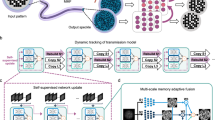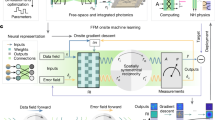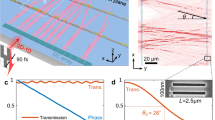Abstract
The direct optical transportation of images through multimode fibres (MMFs) is highly sought after in compact photonic systems for MMF-based optical information processing. However, MMFs are highly scattering media, thus degrading information transmitted through them. Existing approaches utilize artificial neural networks or spatial light modulators to reconstruct images scrambled after propagation through the fibre. Despite these advances, achieving direct optical image transportation through MMFs using integrated optical elements with micrometre-scale footprints remains challenging. Here we develop a miniaturized diffractive neural network (DN2s) integrated on the distal facet of a MMF for the direct all-optical image transportation through the fibre. The DN2s has a footprint of 150 μm by 150 μm and is fabricated on the facet of a 0.35-m-long MMF using three-dimensional two-photon nanolithography. The fibre-integrated DN2s enables single-shot optical transportation of images with flat phases in real time for a constant configuration of the MMF. The system achieves a minimum image reconstruction feature size of approximately 4.90 μm over a field of view 65 μm by 65 μm when imaging handwritten digits. Transfer learning is also demonstrated by the direct optical transportation of HeLa cell images projected by spatial light modulators, which were not part of the training dataset. The concept and implementation pave the way to the integration of miniaturized DN2s with MMFs for compact photonic systems with unprecedented functionalities.
This is a preview of subscription content, access via your institution
Access options
Access Nature and 54 other Nature Portfolio journals
Get Nature+, our best-value online-access subscription
$32.99 / 30 days
cancel any time
Subscribe to this journal
Receive 12 print issues and online access
$259.00 per year
only $21.58 per issue
Buy this article
- Purchase on SpringerLink
- Instant access to full article PDF
Prices may be subject to local taxes which are calculated during checkout






Similar content being viewed by others
Data availability
All data needed to evaluate the conclusions in this article are available via Code Ocean at https://codeocean.com/capsule/9464191/tree/v1. Additional data related to this paper may be requested from the corresponding authors.
Code availability
The custom code and algorithm used to calculate the DN2s for speckled image reconstruction within this article are available via Code Ocean at https://codeocean.com/capsule/9464191/tree/v1.
References
Mitra, P. P. & Stark, J. B. Nonlinear limits to the information capacity of optical fiber communications. Nature 411, 1027–1030 (2001).
Čižmár, T. & Dholakia, K. Exploiting multimode waveguides for pure fibre-based imaging. Nat. Commun. 3, 1027 (2012).
Constable, A., Kim, J., Mervis, J., Zarinetchi, F. & Prentiss, M. Demonstration of a fiber-optical light-force trap. Opt. Lett. 18, 1867–1869 (1993).
Fu, L. & Gu, M. Fiber‐optic nonlinear optical microscopy and endoscopy. J. Microsc. 226, 195–206 (2007).
Pahlevaninezhad, H. et al. Nano-optic endoscope for high-resolution optical coherence tomography in vivo. Nat. Photonics 12, 540–547 (2018).
Leedumrongwatthanakun, S. et al. Programmable linear quantum networks with a multimode fibre. Nat. Photonics 14, 139–142 (2020).
Hecht, J. Understanding Fiber Optics (Pearson, 2005).
Ren, H. et al. An achromatic metafiber for focusing and imaging across the entire telecommunication range. Nat. Commun. 13, 4183 (2022).
Gigan, S. et al. Roadmap on wavefront shaping and deep imaging in complex media. J. Phys. Photon. 4, 042501 (2022).
Wen, Z. et al. Single multimode fibre for in vivo light-field-encoded endoscopic imaging. Nat. Photonics 17, 679–687 (2023).
Richardson, D. J., Fini, J. M. & Nelson, L. E. Space-division multiplexing in optical fibres. Nat. Photonics 7, 354–362 (2013).
Cristiani, I. et al. Roadmap on multimode photonics. J. Opt. 24, 083001 (2022).
Goel, S. et al. Inverse design of high-dimensional quantum optical circuits in a complex medium. Nat. Phys. 20, 232–239 (2024).
Teğin, U., Yıldırım, M., Oğuz, İ., Moser, C. & Psaltis, D. Scalable optical learning operator. Nat. Comput. Sci. 1, 542–549 (2021).
Dietrich, P. I. et al. In situ 3D nanoprinting of free-form coupling elements for hybrid photonic integration. Nat. Photonics 12, 241–247 (2018).
Cao, H., Mosk, A. P. & Rotter, S. Shaping the propagation of light in complex media. Nat. Phys. 18, 994–1007 (2022).
Carpenter, J., Eggleton, B. J. & Schröder, J. 110×110 optical mode transfer matrix inversion. Opt. Express 22, 96–101 (2014).
Mahalati, R. N., Gu, R. Y. & Kahn, J. M. Resolution limits for imaging through multi-mode fiber. Opt. Express 21, 1656–1668 (2013).
Papadopoulos, I. N., Farahi, S., Moser, C. & Psaltis, D. Focusing and scanning light through a multimode optical fiber using digital phase conjugation. Opt. Express 20, 10583–10590 (2012).
Turtaev, S. et al. High-fidelity multimode fibre-based endoscopy for deep brain in vivo imaging. Light Sci. Appl. 7, 92 (2018).
Popoff, S. M. et al. Measuring the transmission matrix in optics: an approach to the study and control of light propagation in disordered media. Phys. Rev. Lett. 104, 100601 (2010).
Choi, Y. et al. Scanner-free and wide-field endoscopic imaging by using a single multimode optical fiber. Phys. Rev. Lett. 109, 203901 (2012).
Li, S. et al. Compressively sampling the optical transmission matrix of a multimode fibre. Light Sci. Appl. 10, 88 (2021).
Li, S., Horsley, S. A., Tyc, T., Čižmár, T. & Phillips, D. B. Memory effect assisted imaging through multimode optical fibres. Nat. Commun. 12, 3751 (2021).
Būtaitė, U. G. et al. How to build the “optical inverse” of a multimode fibre. Intell Comput. 2022, 9816026 (2022).
Kupianskyi, H., Horsley, S. A. & Phillips, D. B. All-optically untangling light propagation through multimode fibers. Optica 11, 101–112 (2024).
Lim, J. & Psaltis, D. MaxwellNet: physics-driven deep neural network training based on Maxwell’s equations. APL Photonics 7, 011301 (2022).
Caramazza, P., Moran, O., Murray-Smith, R. & Faccio, D. Transmission of natural scene images through a multimode fibre. Nat. Commun. 10, 2029 (2019).
Rahmani, B. et al. Multimode optical fiber transmission with a deep learning network. Light Sci. Appl. 7, 69 (2018).
Borhani, N., Kakkava, E., Moser, C. & Psaltis, D. Learning to see through multimode fibers. Optica 5, 960–966 (2018).
Liu, Z. et al. All-fiber high-speed image detection enabled by deep learning. Nat. Commun. 13, 1433 (2022).
Bertolotti, J. & Katz, O. Imaging in complex media. Nat. Phys. 18, 1008–1017 (2022).
Lu, K. et al. Empowering high-dimensional optical fiber communications with integrated photonic processors. Nat. Commun. 15, 3515 (2024).
Kues, M. et al. Quantum optical microcombs. Nat. Photon 13, 170–179 (2019).
Zhang, Q., Yu, H., Barbiero, M., Wang, B. & Gu, M. Artificial neural networks enabled by nanophotonics. Light Sci. Appl. 8, 42 (2019).
Psaltis, D. et al. Holography in artificial neural networks. Nature 343, 325–330 (1990).
Lin, X. et al. All-optical machine learning using diffractive deep neural networks. Science 361, 1004–1008 (2018).
Goi, E., Schoenhardt, S. & Gu, M. Direct retrieval of Zernike-based pupil functions using integrated diffractive deep neural networks. Nat. Commun. 13, 7531 (2022).
Kulce, O., Mengu, D., Rivenson, Y. & Ozcan, A. All-optical synthesis of an arbitrary linear transformation using diffractive surfaces. Light Sci. Appl. 10, 196 (2021).
Li, Y., Luo, Y., Mengu, D., Bai, B. & Ozcan, A. Quantitative phase imaging (QPI) through random diffusers using a diffractive optical network. Light Adv. Manuf. 4, 206–221 (2023).
Zhang, Y. et al. Memory-less scattering imaging with ultrafast convolutional optical neural networks. Sci. Adv. 10, eadn2205 (2024).
Rahman, M. S. S. et al. Learning diffractive optical communication around arbitrary opaque occlusions. Nat. Commun. 14, 6830 (2023).
Yuan, G. H., Rogers, E. T. & Zheludev, N. I. Achromatic super-oscillatory lenses with sub-wavelength focusing. Light Sci. Appl. 6, e17036 (2017).
Kuchmizhak, A., Gurbatov, S., Nepomniaschii, A., Vitrik, O. & Kulchin, Y. High-quality fiber microaxicons fabricated by a modified chemical etching method for laser focusing and generation of Bessel-like beams. Appl. Opt. 53, 937–943 (2014).
Plöschner, M., Tyc, T. & Čižmár, T. Seeing through chaos in multimode fibres. Nat. Photonics 9, 529–535 (2015).
Ebner, F. H. et al. Developments in neuroendoscopy: trial of a miniature rigid endoscope with a multidirectional steerable tip camera in the anatomical lab. Neurosurg. Rev. 35, 45–51 (2012).
Lecun, Y., Bottou, L., Bengio, Y. & Haffner, P. Gradient-based learning applied to document recognition. Proc. IEEE 86, 2278–2324 (1998).
Vasquez-Lopez, S. A. et al. Subcellular spatial resolution achieved for deep-brain imaging in vivo using a minimally invasive multimode fiber. Light Sci. Appl. 7, 110 (2018).
Porte, X. et al. Direct (3+1)D laser writing of graded-index optical elements. Optica 8, 1281–1287 (2021).
Hu, X., Zhao, J., Antonio-Lopez, J. E., Correa, R. A. & Schülzgen, A. Unsupervised full-color cellular image reconstruction through disordered optical fiber. Light Sci. Appl. 12, 125 (2023).
Acknowledgements
This work was supported by the funding from the National Key Research and Development Program of China (grant no. 2021YFB2802000, Q.Z.), the National Key Research and Development Program of China (grant no. 2022YFB2804301, H.L.), the Science and Technology Commission of Shanghai Municipality (grant no. 21DZ1100500, M.G.), the Shanghai Municipal Science and Technology Major Project, the Shanghai Frontiers Science Center Program (grant no. 2021-2025 No. 20, M.G.), the National Natural Science Foundation of China (grant no. 61975123, Q.Z.; 62305219, S.L.; 62205208, H.Y.), the Shanghai Natural Science Foundation (grant no. 23ZR1443200, S.L.), the China Postdoctoral Science Foundation (2022M712138, S.L.; 2021M702192, H.Y.) and the Shanghai Super Postdoctoral Incentive Scheme (5B22904002, S.L.; 5B22904006, H.Y.).
Author information
Authors and Affiliations
Contributions
H.Y., Q.Z. and M.G. conceived the concept. M.G. and Q.Z. supervised the project. Z.H. and Q.W. contributed to the implementation of the programming of the diffractive neural networks. B.W. contributed to offering professional advice in the fabrication experiments while he was employed by the University of Shanghai for Science and Technology. H.D., from South East China University, S.L. and J.L. contributed in offering generous suggestions in the characterization and fabrication systems. H.Y. and Q.W. carried out the numerical and experimental characterization of the device. All authors participated in discussions and contributed to the writing of the paper.
Corresponding authors
Ethics declarations
Competing interests
The authors declare no competing interests.
Peer review
Peer review information
Nature Photonics thanks Juergen Czarske, Qing Yang and the other, anonymous, reviewer(s) for their contribution to the peer review of this work.
Additional information
Publisher’s note Springer Nature remains neutral with regard to jurisdictional claims in published maps and institutional affiliations.
Supplementary information
Supplementary Information
Supplementary Notes 1–11, Figs. 1–24 and Table 1.
Supplementary Video 1
Theoretical modelling of the scanning spots reconstruction results.
Supplementary Video 2
Experimental results of the scanning spots reconstruction at the distal facet.
Supplementary Video 3
DN2s and U-net reconstruction results of natural scenes scrambled by the multimode fibre.
Supplementary Video 4
Experimental video showing the fibre integration of DN2s using the two-photon nanolithographic technique.
Rights and permissions
Springer Nature or its licensor (e.g. a society or other partner) holds exclusive rights to this article under a publishing agreement with the author(s) or other rightsholder(s); author self-archiving of the accepted manuscript version of this article is solely governed by the terms of such publishing agreement and applicable law.
About this article
Cite this article
Yu, H., Huang, Z., Lamon, S. et al. All-optical image transportation through a multimode fibre using a miniaturized diffractive neural network on the distal facet. Nat. Photon. 19, 486–493 (2025). https://doi.org/10.1038/s41566-025-01621-4
Received:
Accepted:
Published:
Issue date:
DOI: https://doi.org/10.1038/s41566-025-01621-4
This article is cited by
-
Universal point spread function engineering for 3D optical information processing
Light: Science & Applications (2025)
-
Optical generative models
Nature (2025)



